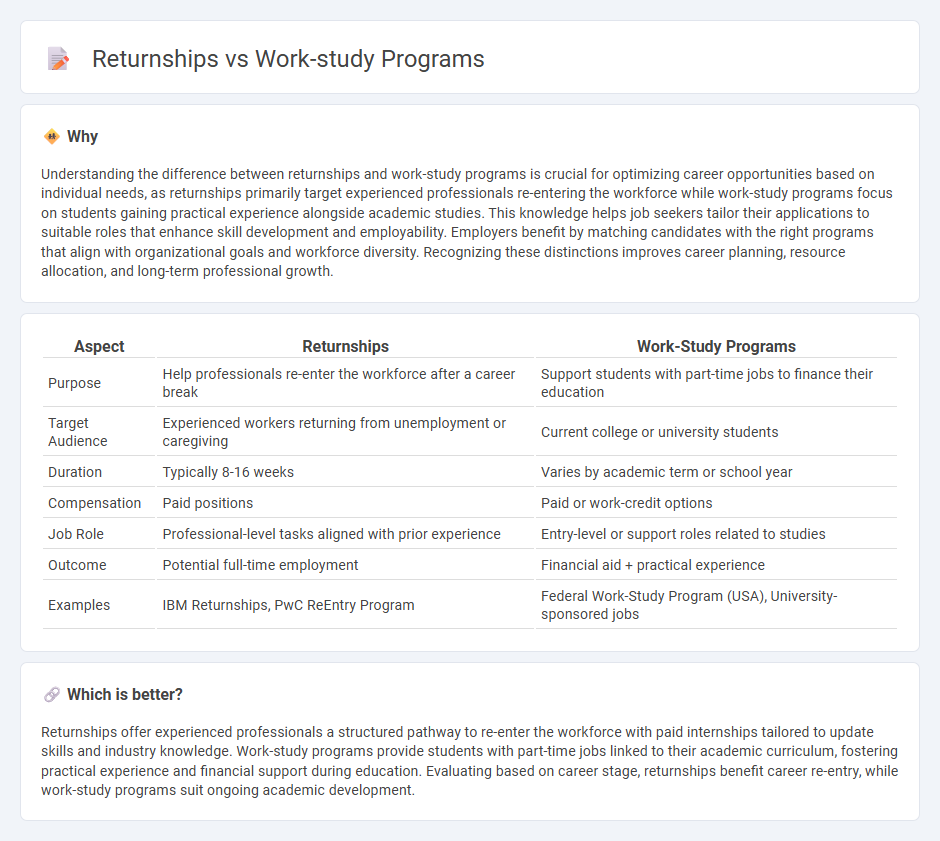
Returnships offer experienced professionals a structured pathway to re-enter the workforce after a career break, focusing on skill refreshment and networking within specific industries. Work-study programs provide students with part-time employment opportunities related to their academic fields, allowing them to gain practical experience while financing their education. Discover how returnships and work-study programs can uniquely support your employment goals and career growth.
Why it is important
Understanding the difference between returnships and work-study programs is crucial for optimizing career opportunities based on individual needs, as returnships primarily target experienced professionals re-entering the workforce while work-study programs focus on students gaining practical experience alongside academic studies. This knowledge helps job seekers tailor their applications to suitable roles that enhance skill development and employability. Employers benefit by matching candidates with the right programs that align with organizational goals and workforce diversity. Recognizing these distinctions improves career planning, resource allocation, and long-term professional growth.
Comparison Table
| Aspect | Returnships | Work-Study Programs |
|---|---|---|
| Purpose | Help professionals re-enter the workforce after a career break | Support students with part-time jobs to finance their education |
| Target Audience | Experienced workers returning from unemployment or caregiving | Current college or university students |
| Duration | Typically 8-16 weeks | Varies by academic term or school year |
| Compensation | Paid positions | Paid or work-credit options |
| Job Role | Professional-level tasks aligned with prior experience | Entry-level or support roles related to studies |
| Outcome | Potential full-time employment | Financial aid + practical experience |
| Examples | IBM Returnships, PwC ReEntry Program | Federal Work-Study Program (USA), University-sponsored jobs |
Which is better?
Returnships offer experienced professionals a structured pathway to re-enter the workforce with paid internships tailored to update skills and industry knowledge. Work-study programs provide students with part-time jobs linked to their academic curriculum, fostering practical experience and financial support during education. Evaluating based on career stage, returnships benefit career re-entry, while work-study programs suit ongoing academic development.
Connection
Returnships and work-study programs both serve as structured pathways to re-enter or enter the workforce by combining practical experience with learning opportunities. Returnships specifically target experienced professionals looking to resume their careers after a break, while work-study programs primarily support students by integrating academic education with part-time work. These initiatives enhance employability by bridging skill gaps and fostering workforce readiness through hands-on experience and mentorship.
Key Terms
Eligibility
Work-study programs primarily target current students enrolled in accredited institutions, offering part-time employment to support educational expenses, while returnships cater to experienced professionals re-entering the workforce after a career break, typically requiring prior relevant work experience. Eligibility for work-study hinges on financial need and enrollment status, whereas returnships emphasize skills, career gap duration, and readiness to update industry knowledge. Discover more about choosing the right program to align with your career goals and eligibility.
Compensation
Work-study programs typically offer hourly wages aligned with minimum wage standards, providing students with financial support while gaining practical experience on campus or affiliated sites. Returnships, designed for professionals re-entering the workforce, often offer stipends or salaries competitive with industry roles, reflecting their advanced skill sets and career levels. Explore detailed comparisons to find which compensation model best suits your career goals and financial needs.
Duration
Work-study programs typically span the duration of an academic semester or year, offering part-time employment integrated with students' coursework to support educational expenses and gain professional experience. Returnships usually last several weeks to a few months, designed specifically for professionals re-entering the workforce after a career break, focusing on skill refreshment and networking opportunities. Discover how choosing the right program can align with your career objectives and time availability.
Source and External Links
Federal Work-Study Program | Georgia Student Finance Commission - A federal program offering part-time jobs to undergraduate and graduate students with financial need, allowing them to earn money to cover education expenses while encouraging community service or work related to their studies.
Federal Work Study | Financial Aid - Georgia Tech - Describes how Federal Work-Study provides part-time jobs for students with financial need, including wages, job locations, restrictions, and management by the school's financial aid office to help pay education costs.
Student Employment - Student Financial Services - Details eligibility, application process, and employment information for the Federal Work-Study Program at Georgia State University, emphasizing how students earn wages to help pay education costs through on- or off-campus jobs.
 dowidth.com
dowidth.com